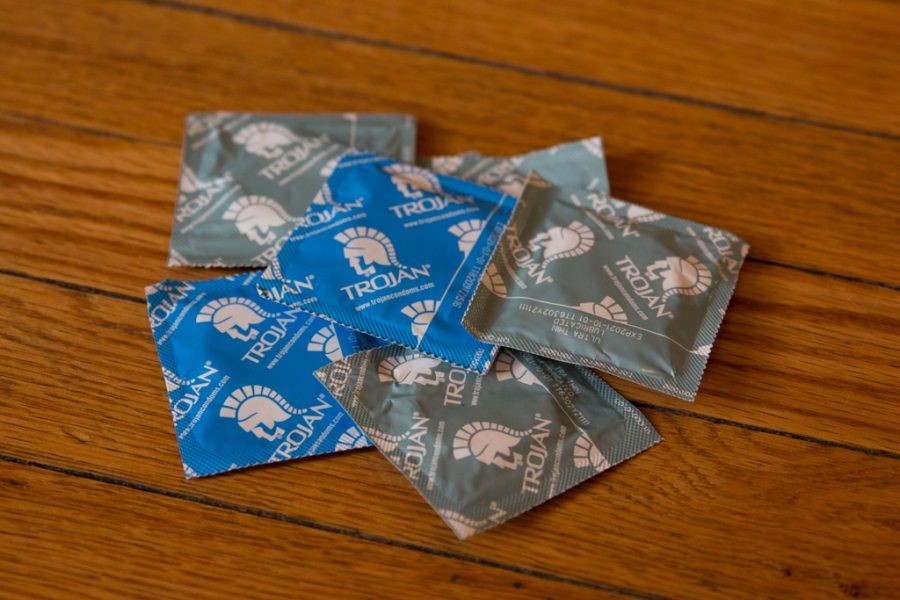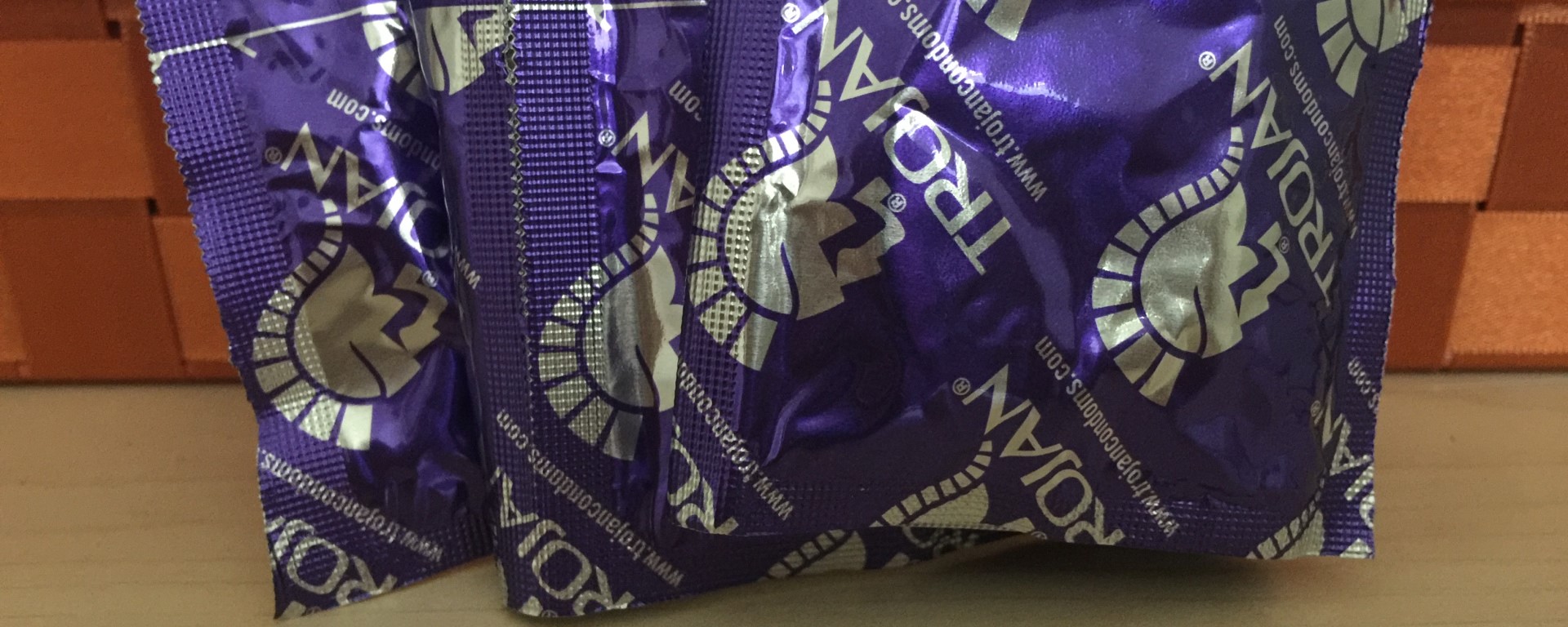See all "Sex and Candida" Section Topics

So, can condoms cause yeast infections? Examining the many studies, we will investigate in this topic’s delineation, we find the answer to this question is a strong “no.” So, no, condoms do not cause yeast infections. If you are a female, one sex act that does increase your risk of getting a yeast infection is receiving oral sex. As the article Sex and Yeast Infection points out, women receiving oral sex has repeatedly been demonstrated to elevate a woman’s risk for yeast infections. Even when a woman masturbates with saliva, this also elevates her risk of developing this kind of vaginal infection. But for the most part, contraceptive use doesn’t influence your odds of getting vaginal Candida—especially simple condom use.
Condom use is a key way to help prevent the spread of sexually transmitted diseases. And, it will likely also help to prevent the spread of a yeast infection—if your sex partner currently has one. Yes, yeast infections are contagious to some degree; and, a protective physical barrier—like a latex condom—can keep the yeast cells from transferring between individuals during sexual contact. So, if anything, a condom will help prevent yeast infections. If you seem to get yeast infections after sex; this may be a reason why you're here—to learn if condoms cause yeast infections. For a more detailed focus on this topic, feel free to check out Yeast Infections After Sex.
Also, please note, some azole antifungal drugs can weaken latex condoms. And, over the counter yeast infection creams / vaginal suppositories, are often made from azole antifungals. Monistat, for instance, is the azole drug miconazole. According to this overview from the United States Center for Disease Control (CDC), latex condoms can be weakened by using some antifungal drugs. The CDC recommends you refer to the condom labeling for more detailed information.
A 1/2 Day & Yeast is Gone!
Linda Allen suffered from yeast infections for years. Through researching natural medicine & Candida, she found an efficacious solution!
Linda is one expert you want on your side! Let her show you how to get rid of a superficial yeast infection in just 12 hours; AND, keep it gone!
A 60-day, 100% money back guarantee is provided.
Visit Official Site!Condom & Candidiasis Research

The first study we will look at, sought to see how a woman’s vaginal microbiota (the composition of the microscopic life in the vagina; i.e., the amount and type of bacteria and fungus living there) was influenced by sexual intercourse with and without condoms. The research was published in the Journal of Infectious Diseases [183.6 (2001): 913-918]. The study enrolled women who were 18 to 40 years old, had regular menstrual cycles, and had one sex partner. The women were without a fungal or bacterial infection; except they could have bacterial vaginosis. The women were allocated into two groups: one group did not use a condom, the other group used a silicone lubricated condom that did not have nonoxynol-9. The women’s vaginal epithelium (the tissue lining the vagina) and flora were studied via histologic (microscopic analysis of tissue), colposcopic (a magnified viewing of the vagina, vulva, or cervix tissues), and gross (viewing with the bare eye) examinations.
The women were examined on the first visit 19 to 24 days after their last menses. The second visit happened one month later. The visits all occurred for the women around the same time of their menstrual cycle; so vaginal examination would correlate with their menstrual cycle. The next visits occurred after the subjects had sex; ranging from 8 hours to 8 days after intercourse. The study found that Candida albicans was present in about 17% of the condom users—this figure being an average of findings at visits 2 through 5. For those women who did not use a condom, Candida albicans was present in about 20.25% of the women—this figure is also an average of findings at visits 2 through 5. Thus, this research shows that condom use does not cause yeast infections. The research had the following to say in their concluding remarks:
In summary, vaginal intercourse both without and with a condom produced no discernable effect on vaginal or cervical epithelium and produced only erythema on vulvar epithelium. It was reassuring that 8 h after vaginal intercourse, no effect was found on vaginal pH, vaginal lactobacilli, or other normal vaginal flora.
http://dx.doi.org/10.1086/319251

Another study, looked into the the presence of various vaginal microorganisms, and possible risk factors for the presence of each microorganism. The study was published in the journal Clinical Microbiology and Infection [15.7 (2009): 670-679]. Vaginal and endocervical cultures were performed on 27,172 non-pregnant females. Various clinical and demographic characteristics of these women were also obtained—one factor was condom use. Candida species were present in 18.1% of these women. The study found that always using a condom only slightly increased a woman’s risk for having Candida species in her vagina. Also, as the number of sexual partners women had increased, so too did their risk for having Candida species in their vagina. The contraception method that most predisposed women to having Candida was an intrauterine device. The study concluded, that various genital problems in women might be a result of chemical products that cause irritation, poor hygiene, or the absence of estrogen effect.
Another study looked specifically at condom use and this practice’s relation to vaginal yeast infections. The research was published in the Scandinavian Journal of Infectious Diseases [39.6-7 (2007): 584-588]. The study included 569 women who had visited a hospital with vaginal complaints of some kind. Of these women, 42.2% of them were found to have Candida species in their vaginas. The study found that 40.2% of the condom users were positive for some type of Candida. Those women who did not use any form of contraception, 37.9% of them had some type of Candida. Thus, this study shows there is not a significant impact on the rate of yeast infections when condoms are used. The study also states, that other research has shown there is no significant difference in having Candida, between contraceptive users and non users. The authors state the following in their concluding remarks:
It has been reported that reproductive age, pregnancy, diabetes, contraception, and antibiotic use correlated positively with both C. albicans and non-albicans spp. isolates. Some studies have shown that there were no significant differences for acquiring Candida infection between contraceptive users and non-users.
http://dx.doi.org/10.1080/00365540601148491

Another study looked at 100 sexually active females and tried to see if there was a relationship between certain factors and the presence of bacterial vaginosis (BV) or vaginal yeast infections. The research was published in the journal Infectious Diseases in Obstetrics and Gynecology [2012 (2012)]. All of the women were currently sexually active, and some used condoms as a contraceptive measure. The study found that Candida albicans was found in 22 of the women. Of these 22 Candida positive women, 11 women infrequently, or never used, condoms; and, 11 of the women frequently used condoms. Thus there was no difference between little to no condom use and frequent condom use—in terms of Candida colonization, that is. Among the women not positive for Candida albicans, about half used condoms frequently, and half had little to no condom use. The study did find a high prevalence of BV and vaginal Candidiasis in those women in a disadvantaged social setting.
Another study looked at the the rate of contraceptive use and the incidence of vaginal Candidiasis. This study was published in the Zahedan Journal of Research in Medical Sciences [18.3 (2016)]. The study involved 350 women; and, among them, about 24% had vaginal tests report positive for yeast. The study also employed a detailed questionnaire to determine vaginal symptoms (discharge, soreness, itching, rashes, etc.), social status, contraceptive use, and hygiene practices. Concerning the contraceptive use, 13.2% of these women were using condoms, 5.7% of them were using injection, 8.9% of them used an intrauterine device, and 23.4% used an oral contraceptive pill. The studies statistical analysis of the data showed that there was no significant correlation between contraception practices and positive Candida cultures.
Another study was done on women with recurrent vaginal infections; and, sought to see if having their male sex partners use condoms would help reduce recurrence. The study was published in the Indian Journal of Medical Research [131.1 (2010)]. In this research, 400 females with recurrent vaginal Candidiasis were recruited for analysis. The maladies looked at by the study included yeast infections, trichomoniasis, and BV. The patients were treated for their particular malady, and given advice on proper hygiene and instructed to have their male sex partner use a condom for 4 months. After treatment, the participating women were called every month for four months; or, when they developed symptoms of a vaginal infection. The study concluded that the use of a condom helped to protect against vaginal infection recurrence.
A final study also looked at condom use and sexual activity to see if there was a correlation with such behaviors and vaginal Candidiasis. The study was published in the journal Sexually Transmitted Infections [80.1 (2004): 48-53]. The research included 153 young females; these women were analyzed for sexually transmitted diseases, symptoms of yeast infections, and asymptomatic yeast development. The study looked for a relationship between practices such as condom use, sex hormones, douching; and the presence of a vaginal infection. Information on condom use was only available for 82 of the women; and, these women were allocated into three groups: always using condoms, sometimes using condoms, or never having used a condom.
The study found that 22% of the women were asymptomatically colonized by Candida. Concerning the 118 sexually active women, 24% of them had some level of yeast in their vaginas. The number of sexual partners had no visible effect on the rate of vaginal yeast colonization. Among the sexually active women, the presence of Candida was not influenced by douching or condom use.
Eliminate Bacterial Vaginosis & Vaginal Odor
Jennifer O’Brien is one prominent expert on BV that knows how to get rid of vaginal odor. BV is a common infection that you don’t have to put up with.
Jennifer will show you how to naturally eliminate vaginal odor in just 3 days.
A 60-day, 100% money back guarantee is provided.
Visit Official Site!Eliminate Your Yeast Infection in 12 Hours—Naturally

Many women are the unfortunate victims of recurrent yeast infections; and a wide host of horrible health problems due to excessive amounts of yeast in their bodies. Linda Allen, was one of these unfortunate women who also had this problem. And, there are plenty of men out there that also fall victim to too much Candida in their bodies. Linda, however, was different, instead of giving up and accepting a lifetime of suffering, she put in considerable effort and finally arrived at a natural solution to permanently stop yeast infections. And, Linda’s cure is so effective it can even get rid of a yeast infection in just 12 hours time.
Although Linda is now yeast free, her health wasn’t always this amazing. Linda’s problems started in her late teen years; about the same time she developed a sinus infection. Linda suddenly came down with a yeast infection; and, she wasted little time making an appointment with her physician. Linda’s doctor quickly prescribed her a drug to clear up her infection. At first, everything worked fine; and, Linda was back to her normal self. Yet, shortly after she was free of the yeast infection, she got another one. Again, Linda went to her doctor for another prescription. The drugs Linda used worked well, as they did the first time. Disappointingly, it wasn’t long before Linda was feeling the miserable symptoms of a yeast infection yet again.
This cycle of yeast infection recurrence would go on for about a decade in Linda’s life. If the frequent Candida attacks were not bad enough, Linda’s general health was also spiraling out of control. Like many victims of a systemic yeast infection, Linda felt horrible. She would frequently go to the doctor for a solution; but, she would only get stronger and stronger doses of antibiotics to address peripheral symptoms of her true, deep Candida problem. Her doctor even tried allergy medications; but, nothing seemed to work. Those who knew her may have wondered if she was indeed sicker than she was letting on. In all, her frequent visits to the doctor and prescription drug bills were adding up; and, she was relegated to living in a tiny apartment.
Linda’s life finally reached a positive turning point when she visited a naturopath to see if she could get some answers. The naturopath quickly diagnosed her with a systemic Candida problem; Linda now knew her health issues were all due to yeast in her body. Although the naturopath couldn’t provide any permanent solution for her, Linda did get pointed in the right direction. Linda began spending considerable time researching Candida and trying a host of alternative therapies. She would ask questions of doctors and natural medicine experts who were kind enough to give her some of their time.
With each passing day, Linda began to gain relevant insights into how Candida worked to invade the body. Although no one source she investigated gave Linda a full answer, the insights she gained from her study eventually began to show her a possible way to treat herself. Linda then finally put together a novel, new treatment approach to deal with the root causes of Candida overgrowth and decided to try it on herself. Linda spent the next year polishing and refining her therapy; and, then finally gave it a try. Shortly after she began her treatment, she found her yeast infections rapidly cleared up. As time went on, the familiar Candida outbreaks remained gone. Additionally, as the weeks passed, her general health began to rapidly improve and she felt like her old, healthy self again. Today Linda is still yeast free, and she has decisively broken the chains of bad health due to Candida.
Linda shared her discoveries with others; and, found they rapidly got rid of their yeast infections using her methods. Linda has since gone on to write an entire comprehensive book on how to achieve the same results she did. Linda also guarantees her book will get rid of your yeast infection in just 12 hours time. Since Linda published her book in 2004, over 100,000 people from around the world have used Linda’s book and seen their yeast infections rapidly healed.
Linda’s book is published with a large online, digital retailer—a subsidiary of the large, U.S. based firm Keynetics Incorporated. Linda does guarantee that your yeast infection will be gone in 12 hours with a 60 day, 100% money back guarantee. If you decide to try her book, and you don’t see these results, you can quickly contact her publisher for a full, prompt refund of the money you used to purchase her book. And, there is no need to wait for anything to be mailed as Linda’s book can be downloaded instantly.
For more information on Linda’s personal journey to better health, to see multiple testimonies from others who gave her book a try, or to see some of the bonus books Linda offers for free when you try hers, you can find this information at Linda Allen’s website.
Author: Mr. Nicholas Gross

Nick Gross is a natural medicine enthusiast who has been researching and writing about natural medicine since 2008. Nick is primarily a web developer but also researches and authors written and video content about natural health. Nick has a bachelor’s degree in Management Information Systems from the University of Northern Iowa.
Disclaimer
The information on this website is not a prescription for anyone. This information is for informational or educational purposes only, and is not a substitute for professional medical advice or consultations with healthcare professionals.
Affiliate Disclosure
Some of the links provided on this website are affiliate links. When a purchase is made through these links, Candida Hub earns money from commission. This helps to keep the website up and helpful to people for free. Thank you for any support!
Stay Up to Date
If you enjoyed this article, consider following / liking our Facebook page. This page is primarily utilized to alert followers of new articles that are put on Candida Hub. Candida related news is also discussed. While you are there, you can see what has been more recently added to Candida Hub.
Clair Goodall: Author & Nature Lover
Clair Goodall is a bee-obsessed natural medicine convert from Minnesota. She is one expert you might want to know more about!
Clair will help you protect you and your family from toxic products and chemicals and help you discover solutions from nature.
Also, Clair’s book is backed by a 60-day, 100% money back guarantee
Visit Official Site!SOURCES:
- http://dx.doi.org/10.1086/319251 — Eschenbach, David A., et al. "Effects of vaginal intercourse with and without a condom on vaginal flora and vaginal epithelium." Journal of Infectious Diseases 183.6 (2001): 913-918. PubMed, PDF Available Here
- http://dx.doi.org/10.1111/j.1469-0691.2009.02842.x — Tibaldi, C., et al. "Vaginal and endocervical microorganisms in symptomatic and asymptomatic non?pregnant females: risk factors and rates of occurrence." Clinical Microbiology and Infection 15.7 (2009): 670-679. PubMed, PDF Available Here
- http://dx.doi.org/10.1080/00365540601148491 — Cetin, Meryem, et al. "Distribution of Candida species in women with vulvovaginal symptoms and their association with different ages and contraceptive methods." Scandinavian journal of infectious diseases 39.6-7 (2007): 584-588. PubMed
- http://dx.doi.org/10.1155/2012/378640 — Moreira Mascarenhas, Rita Elizabeth, et al. "Prevalence and risk factors for bacterial vaginosis and other vulvovaginitis in a population of sexually active adolescents from Salvador, Bahia, Brazil." Infectious diseases in obstetrics and gynecology 2012 (2012). PubMed Full Text
- http://dx.doi.org/10.17795/zjrms-6250 — Habibipour, Reza. "Prevalence Rate of Vulvovaginal Candidiasis and Identification of Candida Species in Women in Referred to Hamedan Hospitals 2013-2014, West of Iran." Zahedan Journal of Research in Medical Sciences 18.3 (2016).
- http://www.ncbi.nlm.nih.gov/pubmed/20167978 — Thulkar, Jyoti, et al. "Aetiology & risk factors of recurrent vaginitis & its association with various contraceptive methods." Indian Journal of Medical Research 131.1 (2010). PDF Available Here
- http://dx.doi.org/10.1136%2Fsti.2002.003855 — Barousse, M. M., et al. "Vaginal yeast colonisation, prevalence of vaginitis, and associated local immunity in adolescents." Sexually transmitted infections 80.1 (2004): 48-53. PDF Available Here








